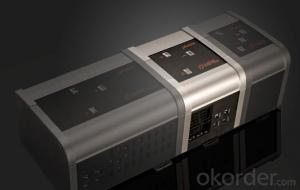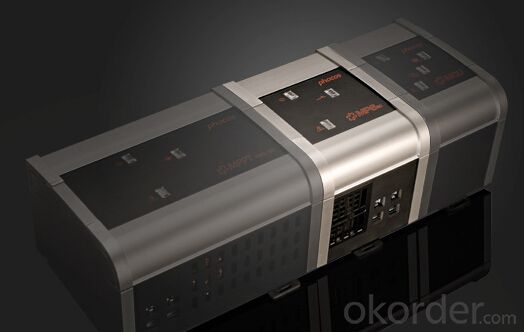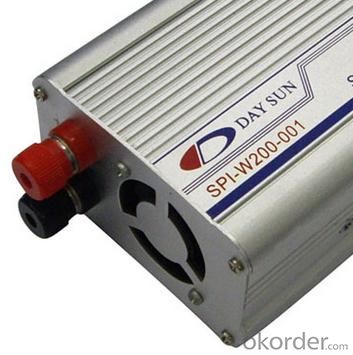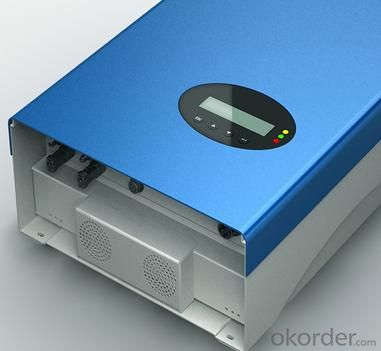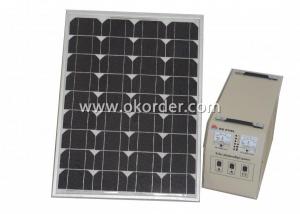Solar Phocos AG MPS (45 – 80 A) Modular Power Switch High Quality for Solar Energy Systems in Alaska
- Loading Port:
- China Main Port
- Payment Terms:
- TT or LC
- Min Order Qty:
- -
- Supply Capability:
- 10000 unit/month
OKorder Service Pledge
OKorder Financial Service
You Might Also Like
1, Product desciption
Inverter circuits designed to produce a variable output voltage range are often used within motor speed controllers.
The DC power for the inverter section can be derived from a normal AC wall outlet or some other source. Control and feedback circuitry is used to adjust the final output of the inverter section which will ultimately determine the speed of the motor operating under its mechanical load.
Motor speed control needs are numerous and include things like: industrial motor driven equipment, electric vehicles, rail transport systems, and power tools. (See related: variable-frequency drive ) Switching states are developed for positive, negative and zero voltages as per the patterns given in the switching Table.
The generated gate pulses are given to each switch in accordance with the developed pattern and thus the output is obtained.
2, Features of the product
Inverters convert low frequency main AC power to higher frequency for use in induction heating.
To do this, AC power is first rectified to provide DC power. The inverter then changes the DC power to high frequency AC power. Due to the reduction in the number of DC Sources employed, the structure becomes more reliable and the output voltage has higher resolution due to an increase in the number of steps so that the reference sinusoidal voltage can be better achieved.
This configuration has recently become very popular in AC power supply and adjustable speed drive applications. This new inverter can avoid extra clamping diodes or voltage balancing capacitors. There are three kinds of level shifted modulation techniques, namely:
· Built-in 1 year data logger for system analysis
· Charge and discharge status display
· Acoustic load disconnect pre-warning
· Load status indication
· Choose between 5 load disconnect algorithms
· Boost/absorption/float PWM-regulation (series type)
· Integrated temperature compensation
· Covered terminals (up to 16 mm2 wire size)
· Full solid-state protection
The first thing to figure out is the length of road in need of street lights.
This can be a small entrance road only a couple hundred of feet long to miles of streets through an area. Does the area currently have any type of lighting available.
What is the reason for needing street lights in this area
Is the electrical grid already nearby or would you need to call in the power company to bring in electrical lines.
If the electric needs to be brought to the area, how much is this going to cost? Depending on how far the grid electric is from the location of the needed lighting, this can be quite expensive.Solar power is energy from the sun. "Solar" is the Latin word for "sun" and
And Powerful source of energy. Without it, there will be no life.
Solar energy is considered as a serious source of energy for many years
of the vast amounts of energy that is made freely available, if harnessed by modern technology.
How much lighting is needed on the street? Do the lights need to be dark sky compliant.
Do the street lights need to run from dusk to dawn or for only a specified number of hours at night.
Are the street lights able to dim in the middle of the night and still provide enough lighting.
These questions need to be answered before you can decide on how many lights you will need to complete the project.
3, Product Image
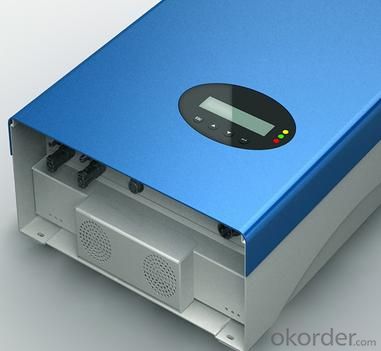
4, Detailed Specification
INPUT | |
Input voltage range | 185~265±5Vac |
OUTPUT | |
Output voltage range | 185~265±5Vac (AC mode) , 230Vac (DC mode) |
Output frequency (DC mode) | 50Hz (48~54Hz) or 60Hz(58~64Hz), same as AC(AC mode) 50Hz ±0.3Hz (DC mode) |
Wave form | Sine wave (DC Mode) |
Transfer time | 10ms. (Typical) |
BATTERY | |
Rated charging current (max.) | 45A |
Norminal DC input voltage | 12V |
Min. DC start voltage | 20V / 40V |
PHYSICAL | |
Unit dimension (mm) | 526*277*212 |
Master box dimension (mm) | 620*350*370 |
Net weight (1pc, kg) | 22.8 |
- Q: Are there any risks of electrical malfunctions or failures during extreme weather events with solar energy systems?
- Yes, there are some risks of electrical malfunctions or failures during extreme weather events with solar energy systems. Severe weather conditions such as hurricanes, tornadoes, hailstorms, or heavy snowfall can potentially damage solar panels, inverters, or electrical wiring, leading to system failures. Additionally, lightning strikes can pose a risk to solar energy systems, potentially causing damage or complete failure. However, proper installation, regular maintenance, and adhering to industry standards can help mitigate these risks and ensure the resilience of solar energy systems during extreme weather events.
- Q: How do solar energy systems contribute to reducing carbon emissions?
- Solar energy systems contribute to reducing carbon emissions in several ways. Firstly, solar energy is a renewable and clean source of power. Solar panels harness sunlight and convert it into electricity without any emissions of greenhouse gases. This means that when solar energy is used to generate electricity, it does not release carbon dioxide or any other harmful pollutants into the atmosphere, unlike traditional fossil fuel power plants. Secondly, solar energy can replace the use of fossil fuels in various sectors. For example, solar panels can be installed on residential rooftops to provide electricity for homes, reducing the need for electricity generated from coal or natural gas. Similarly, solar farms can be established to produce large-scale solar power for commercial and industrial purposes. By displacing the use of fossil fuels, solar energy systems help to lower carbon emissions associated with electricity generation. Moreover, solar energy can also be used for heating purposes. Solar thermal systems can capture and utilize the sun's heat to provide hot water for residential and commercial buildings. By utilizing solar thermal systems, the demand for gas or electricity to heat water is reduced, resulting in a decrease in carbon emissions from water heating processes. Furthermore, the widespread adoption of solar energy systems can lead to a decrease in the overall demand for fossil fuels. As more households, businesses, and industries switch to solar power, the demand for coal, oil, and natural gas decreases. This reduced demand for fossil fuels can drive down their production and consumption, resulting in a significant reduction in carbon emissions associated with extracting, refining, and burning these fuels. In summary, solar energy systems contribute to reducing carbon emissions by producing clean and renewable electricity, replacing the use of fossil fuels, reducing the demand for traditional energy sources, and providing an alternative for heating purposes. By transitioning to solar power, we can significantly mitigate the impact of climate change and work towards a more sustainable future.
- Q: What are the advantages of using solar energy systems?
- There are several advantages of using solar energy systems. Firstly, solar energy is a renewable and sustainable source of power, meaning it will never run out. Secondly, using solar energy reduces dependence on fossil fuels, which helps mitigate climate change and air pollution. Additionally, solar energy systems require minimal maintenance and have a long lifespan, resulting in cost savings over time. Finally, solar energy systems can provide energy independence and stability, especially in remote areas where access to traditional power grids may be limited.
- Q: Are there any financing options available for purchasing solar energy systems?
- Yes, there are several financing options available for purchasing solar energy systems. One common option is to take out a solar loan, which allows homeowners to borrow money specifically for the purchase and installation of a solar energy system. These loans typically have low interest rates and flexible repayment terms, making them an affordable option for many homeowners. Another financing option is to lease a solar energy system. With a solar lease, homeowners can have a solar energy system installed on their property without having to pay for the equipment upfront. Instead, they make monthly lease payments to the solar company in exchange for using the solar energy generated by the system. This option is especially popular for homeowners who don't want the responsibility of maintaining and repairing the equipment themselves. Additionally, some states and municipalities offer solar incentives and tax credits to help offset the cost of installing solar energy systems. These incentives can include grants, rebates, or tax credits that reduce the upfront costs of purchasing and installing solar panels. It's important to research what incentives are available in your area, as they can significantly reduce the overall cost of going solar. Finally, some solar companies offer power purchase agreements (PPAs), where homeowners pay for the solar electricity they use at a predetermined rate. This option allows homeowners to benefit from solar energy without any upfront costs, as the solar company owns and maintains the equipment. While PPAs can be a good option for some homeowners, it's crucial to carefully review the terms and conditions before entering into a contract. Overall, there are various financing options available for purchasing solar energy systems, making it more accessible and affordable for homeowners to transition to clean and renewable energy sources.
- Q: Can solar energy systems be used for powering electric scooter charging stations?
- Yes, solar energy systems can be used to power electric scooter charging stations. Solar panels can be installed to harness energy from the sun, which can then be converted into electricity and used to charge electric scooters. This renewable energy source provides a sustainable and eco-friendly solution for powering charging stations, reducing reliance on traditional electricity grids and decreasing carbon emissions.
- Q: Can solar energy systems be installed on historical buildings?
- Yes, solar energy systems can be installed on historical buildings. However, it requires careful consideration and expertise to ensure that the installation does not compromise the historical integrity of the building. Solar panels can be mounted on rooftops or integrated into the building's design in a visually appealing and non-intrusive manner. Historic preservation guidelines, local regulations, and the expertise of architects and preservation professionals play a crucial role in determining the feasibility and appropriate installation methods for solar energy systems on historical buildings.
- Q: Can solar energy systems be used for powering off-grid eco-tourism destinations?
- Yes, solar energy systems can definitely be used for powering off-grid eco-tourism destinations. Solar panels can be installed to harness the power of the sun and convert it into electricity, providing a sustainable and clean energy source for these destinations. This not only reduces their dependence on traditional fossil fuel generators but also minimizes their carbon footprint, aligning with the eco-friendly practices of these destinations. Additionally, solar energy systems can be designed to store excess energy in batteries, ensuring a continuous power supply even when the sun is not shining.
- Q: Can solar energy systems be installed on any type of roof?
- Yes, solar energy systems can be installed on any type of roof. However, the suitability and feasibility may vary depending on factors such as the roof's material, age, orientation, and structural integrity. It is advisable to consult with a professional solar installer to determine the best approach for your specific roof type.
- Q: Can solar energy systems be installed on sports stadiums?
- Yes, solar energy systems can be installed on sports stadiums. Many sports stadiums around the world have successfully implemented solar energy systems to generate renewable and clean electricity. These systems are typically installed on the roofs of stadiums or in nearby open areas to maximize sunlight exposure. By harnessing solar power, sports stadiums can reduce their reliance on fossil fuels, lower their carbon footprint, and contribute to a more sustainable future.
- Q: Can solar energy systems be installed in areas with high snowfall?
- Yes, solar energy systems can be installed in areas with high snowfall. While snow can temporarily reduce the efficiency of solar panels by covering them, it is still possible to generate electricity from solar energy during winter months. Additionally, advancements in technology have led to the development of snow-shedding designs and tilt systems that can help minimize snow accumulation on panels. Regular maintenance and cleaning can further optimize the system's performance in snowy conditions.
Send your message to us
Solar Phocos AG MPS (45 – 80 A) Modular Power Switch High Quality for Solar Energy Systems in Alaska
- Loading Port:
- China Main Port
- Payment Terms:
- TT or LC
- Min Order Qty:
- -
- Supply Capability:
- 10000 unit/month
OKorder Service Pledge
OKorder Financial Service
Similar products
Hot products
Hot Searches
Related keywords
